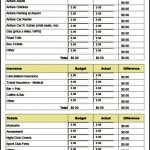Project Plan Template For Lean Projects
Project Plan Template for Lean Projects
Lean project management focuses on eliminating waste and maximizing value. A Lean project plan template helps streamline the planning process, ensuring alignment with Lean principles. This template provides a flexible framework for managing Lean projects effectively. Unlike traditional, heavily detailed plans, a Lean project plan emphasizes adaptability, collaboration, and iterative progress.
Key Elements of a Lean Project Plan Template
- Project Vision/Goal:
This clearly defines the desired outcome of the project. It should be concise, measurable, achievable, relevant, and time-bound (SMART). Articulating the vision helps align the team and stakeholders on the project’s purpose and expected benefits. Consider using a problem statement format: “To solve [problem], we will achieve [goal] by [date] resulting in [benefit].”
- Project Scope:
While Lean aims for flexibility, defining the initial scope is crucial. This outlines what is included in the project and, equally importantly, what is not. Focus on the Minimum Viable Product (MVP) – the smallest set of features that delivers value. Avoid “scope creep” by rigorously evaluating any new requests against the project vision and value proposition. Document assumptions, constraints, and dependencies impacting the scope.
- Value Stream Mapping:
Value stream mapping visualizes the steps involved in delivering value to the customer. This helps identify waste (Muda) in the process, such as defects, overproduction, waiting, non-utilized talent, transportation, inventory, motion, and extra processing. The map shows both the current state and the desired future state, highlighting areas for improvement. Create separate maps for different value streams if the project is complex.
- Kanban Board:
A Kanban board is a visual tool used to manage workflow. It typically consists of columns representing different stages of the project, such as “To Do,” “In Progress,” and “Done.” Tasks are represented as cards that move across the board as they progress. Kanban promotes transparency, limits work in progress (WIP), and facilitates continuous flow. Customize the columns to reflect the specific workflow of your project. Use digital tools or physical boards depending on team preferences and location.
- Backlog:
The backlog is a prioritized list of tasks or user stories that need to be completed. Each item should be small, independent, negotiable, valuable, estimable, and testable (INVEST). Prioritize items based on their value and impact. Use techniques like MoSCoW (Must have, Should have, Could have, Won’t have) to guide prioritization. Regularly refine the backlog based on feedback and changing priorities. The product owner (if you’re using Scrum concepts) is responsible for maintaining the backlog.
- Sprints (Iterations):
Lean projects often use short iterations (sprints) to deliver incremental value. Sprints are typically 1-4 weeks long. At the beginning of each sprint, the team selects items from the backlog to work on. Daily stand-up meetings (15 minutes or less) are held to discuss progress, identify roadblocks, and plan the day’s work. At the end of each sprint, the team demonstrates the completed work and gathers feedback. Sprint planning and sprint review are crucial for continuous improvement.
- Risk Management:
While Lean emphasizes quick adaptation, identifying potential risks is still important. Conduct a risk assessment to identify potential threats and opportunities. Develop mitigation strategies for high-priority risks. Regularly review and update the risk register as the project progresses. Focus on risks that could significantly impact the project’s value or timeline.
- Communication Plan:
Establish a clear communication plan to ensure that all stakeholders are informed about the project’s progress. Define communication channels, frequency, and target audiences. Use visual communication tools like Kanban boards and burn-down charts to promote transparency. Regular communication helps build trust and collaboration within the team and with stakeholders. This includes frequency of standups, sprint reviews, and stakeholder reports.
- Metrics and Measurement:
Identify key metrics to track project progress and measure success. Examples include cycle time, lead time, throughput, and customer satisfaction. Use visual dashboards to track these metrics and identify areas for improvement. Regularly review the metrics and adjust the project plan as needed. Focus on metrics that directly reflect the project’s value and impact.
- Feedback Loops:
Establish feedback loops to continuously improve the project. Gather feedback from customers, stakeholders, and the team at regular intervals. Use this feedback to refine the product, process, and project plan. Incorporate lessons learned from each sprint into future iterations. Retrospectives at the end of each sprint are essential for identifying areas for improvement.
Benefits of Using a Lean Project Plan Template
- Increased Efficiency: Eliminates waste and streamlines processes.
- Improved Collaboration: Fosters teamwork and communication.
- Enhanced Customer Value: Focuses on delivering the most valuable features first.
- Greater Flexibility: Adapts to changing requirements and priorities.
- Faster Delivery: Enables incremental delivery of value.
Adapting the Template
This template provides a starting point. Adapt it to fit the specific needs of your project and organization. The key is to maintain a focus on Lean principles: eliminating waste, maximizing value, and continuous improvement. Regularly review and adjust the template based on feedback and lessons learned.
Project Plan Template For Lean Projects :
Project Plan Template For Lean Projects was posted in September 18, 2025 at 6:50 pm. If you wanna have it as yours, please click the Pictures and you will go to click right mouse then Save Image As and Click Save and download the Project Plan Template For Lean Projects Picture.. Don’t forget to share this picture with others via Facebook, Twitter, Pinterest or other social medias! we do hope you'll get inspired by SampleTemplates123... Thanks again! If you have any DMCA issues on this post, please contact us!




